Entries tagged with “Dolcetto”.
Did you find what you wanted?
Thu 6 Jan 2011
Dolcetto is a black wine grape variety widely grown in the Piedmont region of northwest Italy. The Italian word dolcetto means “little sweet one”, but it is not certain that the name originally carried any reference to the grape’s sugar levels: it is possible that it derives from the name of the hills where the vine is cultivated. In any case the wines produced are nearly always dry. They can be tannic and fruity with moderate, or decidedly low, levels of acidity and are typically meant to be consumed one to two years after release.
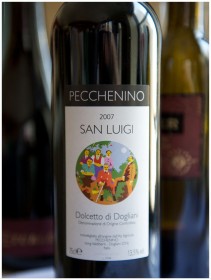 Dolcetto wines are known for black cherry and licorice flavours with some prunes and a characteristically bitter finish reminiscent of almonds. While the name implies sweetness, the wines are normally dry. The tannic nature of the grape contributes to a characteristic bitter finish.
Dolcetto wines are known for black cherry and licorice flavours with some prunes and a characteristically bitter finish reminiscent of almonds. While the name implies sweetness, the wines are normally dry. The tannic nature of the grape contributes to a characteristic bitter finish.
Recently our friend Diana, who runs the great B&B Baur in Aqui Terme, about an hour away from TorreBarolo, visited the town of Dogliani and these are her thoughts:
“A few weeks before Christmas my husband had the idea to take a ride over to the Langhe to taste some wines. He had a specific goal: he wanted to go to the Bottega del Dolcetto di Dogliani, the regional enoteca that is snuggled below the Municipio, right next to the splendid Chiesa dei Santi Quirico e Paolo in the heart of the city.
We had been to the enoteca before; it was from there that we visited the wonderful Chionetti winery for the first time in 2005. Dogliani was actually the center of our property search in 2001 and 2002 before we discovered our hill in the Monferrato. Contructed in the 12th century, Dogliani lies at the basin of the Barolo Valley. The nutrients and minerals that help the Nebbiolo grapes to flourish wash down to provide the perfect conditions for growing the Dolcetto grape. Of the eight zones officially designated to produce Dolcetto DOC, Dogliani is one of the top two. In 2005, Dolcetto Superiore di Dogliani received its DOCG status. With a minimum of 12.5% alcohol content and a hint of oak (the level depending on the winery) aging, Docetto has moved from a sharp, high tannin, low acid, quick-to-table wine with a slightly bitter residual flavor to a more rounded, softer wine that can sit in the bottle a few more years before being enjoyed with a variety of dishes typical to the region.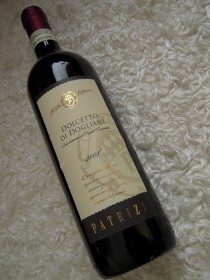
Enzo Romano, who runs the bottega, greeted us and helped Micha find the selection of wines he had been searching for. The Enoteca Regionale in Dogliani is one of the most organized and best run enoteche in the system. It has a current selection of all the producers in the appellation and a good breath of different vintages as well. Enzo helped Micha put together a healthy selection of twelve bottles of Dolcetto, both regular and superiore (wooded), for us to try. After trying, we notate the bottles we like the best and make appointments to visit those wineries.
An ideal combination of classic Piemontese food and wine might be. brodo broth made from winter capon served with boiled vegetables and agnolotti Piemontesi, alongside a 2008 Dogliani Bricco DOCG from the Cascina Minella, a vineyard brought to new life in 2002 by Livia and Gianluca Marchisio. I love this wine. It’s everything a good Dolcetto should be. It has character and bite without being agressive. Its 14% alcohol content and fullness of flavor speak of the patience and timing that the Marchisios exercised in picking the correct moment to harvest.
Dolcetto is not an easy wine to get right. We’ve been experimenting with the wine (from the tasting perspective) for years. To find dolcetto that truly maximizes the grape’s potential requires a producer with excellent soil conditions, the willingness to dedicate precious, southern exposure territory to a relatively humble wine, a sixth sense of timing regarding the harvest, the ability to stave off the many diseases this grape can contract and strong cellar knowlege. In our opinion, the two regions that have a concentration of these types of Dolcetto wineries are most likely to be found in Dogliani and Diano d’Alba.
Of course, there is tremendous enjoyment attached to searching out really spectacular wines from the bunch. Especially when that search takes you through some of the most bucolic and historic growing regions in Italy. We look forward to sharing our thoughts on the wines we’ve bought as we try them.”
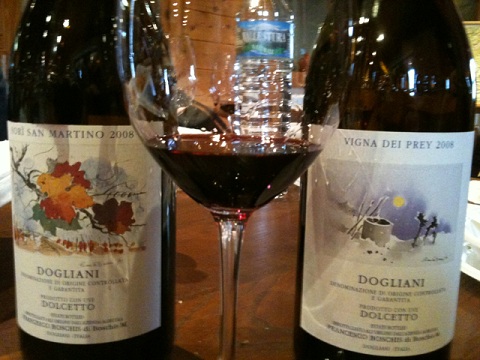
Thu 1 Jul 2010
 Our wine guru Gary Chevsky, back in November 2009, experimented with some Barbera wines from Piemonte:
Our wine guru Gary Chevsky, back in November 2009, experimented with some Barbera wines from Piemonte:
“Unclear why anyone would want to drink aged Barbera, a wine grape that is associated with easy quaffing and everyday meals. In the land where Nebbiolo is firmly the king, why mess with that? Let Barbera and Dolcetto play their lowly part in the food chain. Affordable, refreshing, satisfyingly easy drinking table wines. What would the world do without them, no?
But of course someone is always ready to challenge status quo, try to make an eagle out of a sparrow, a Boeing out of a paper plane. Treat Dolcetto like a more serious grape, and you get Dolcetto di Dogliani, deeper, richer, more ageable. Treat Barbera like that, and what do you get?
On Monday, a small group of enthusiasts got together at a Ross Bott tasting in Los Altos to assess 1999-2001 Barberas by La Spinetta. La Spinetta has a “standard” or lower-end Ca’ Di Pian wine that costs in the teens, and a higher-end wine that costs $40-50. Having tasted Gaja’s 1995 Barbera “Sitorey” earlier this year and having found it a powerful, fresh, and nuanced wine, my expectations were mixed. After all, that was Gaja! Could anyone else approach that effort?
From the mailer by Ross Bott, the organizer:
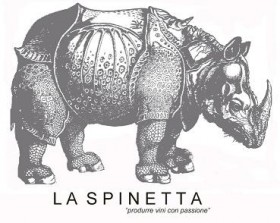
“Barbera is the third most planted red grape varietal planted in Italy, after Sangiovese and Montepulciano. Although planted in many of the northern Italian provinces, it is at its best in the Piedmonte region area around Asti, where it has DOCG status, Italy’s highest classification.
The varietal is naturally high in acid and low in tannins, and, when vinified in a lighter style to be drunk young, is a fine everyday wine to complement pastas and other northern Italian dishes. However, when yields are kept low and the grapes are harvested at riper levels, the resultant wines can be deep, complex and long aging, and marry particularly well with new medium toasted (or charred) oak barrels. Ironically, this approach is a relatively recent phenomenon in Piedmonte. In fact, some of the earliest examples of this approach were in the Shennandoah Valley in California, where Montevina made some great old Special Selection Barberas in the late 1970s — to my view the most exciting wines ever to come out of the Sierra Foothills.
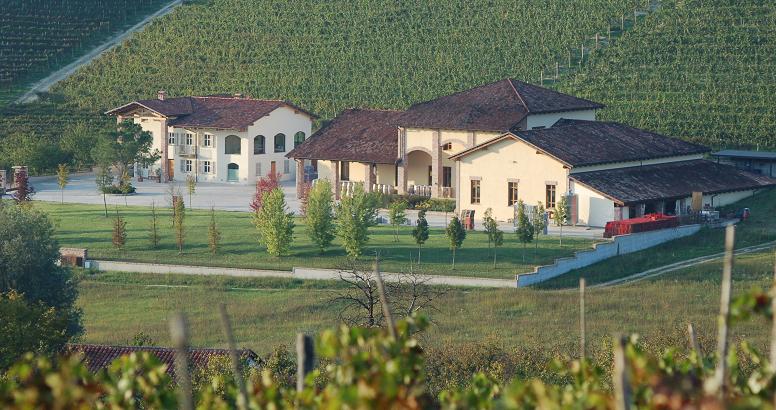
In 1998, Giuseppe Rivetti began to make a Barbera Superiore under his La Spinetta label, a serious, high-end approach involving old vines, low yields, and aging for 12-18 months in new French oak. Rivetti was born in Argentina, but his family was Piedmontese, and he returned in 1977 to the Asti region, in an area then known for Moscato d’Asti, a fragrant, low alcohol wine made from a varietal in the Muscat family. After producing some landmark examples of this white wine, he ventured into reds in 1985, first with Barbera and later adding Barbarescos and Barolos. He produces three Barberas a year, a Ca’ Di Pian which is richer and riper than most Barberas, but sees less oak, a Gallina from a single vineyard which also provides the grapes for his Barbaresco, and a Superiore, which is a reserve bottling from a selection of his best barrels. Both of the latter get extended barrel treatment and are among the three or four best Barberas produced anywhere.
Tonight, we’ll try six La Spinetta Barberas, a pair from each of 1999, 2000 and 2001. One member of each pair will be the lightly oaked Ca’ Di Pian and the other an example of his highest end Barberas which get extended treatment in new oak.”

From what La Spinetta I have tasted, it seems to have a ripe fruity style, perhaps closer to new world than old. On the photos below, the wines are ranked right to left in the order of scores. Easily in our blind tasting, the group ruled that more expensive wines beat out the cheaper ones. Though drinkable, the lower-end ones obviously not built for aging were slightly pickled, dusty, and funky. The higher-end “Superiore” and “Gallina” were in perfectly good shape, maintaining fresh fruit.
While the top 3 wines still “showed” young, it is as if they had artificially been beefed up to last longer, and the age did not give them subtlety, complexity, and secondary flavors that I’ve seen develop in properly aged ageworthy wines. It seemed rather pointless to me to spend $45 a bottle, then cellar it for 10 years, when in that range one finds some wonderful Nebbiolo and Sangiovese options. While obviously we confirmed Barbera’s ageability, I would not call that ageworthiness. It bothered me that the wines lacked finesse and complexity, and the question that firmly stuck in my mind was – “What’s the point!???”
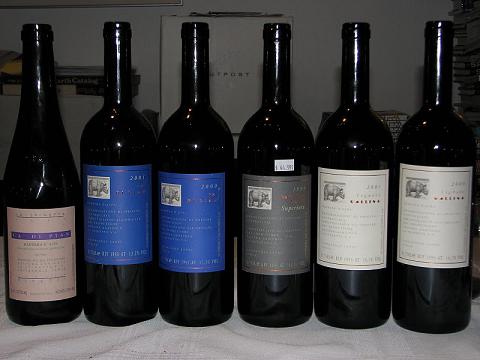
Wed 17 Feb 2010
Having been touring the Langhe for over 10 years, I wonder why I have never considered a visit to Acqui Terme, as it is only an hour north of TorreBarolo, and 30 mins of it is autostrada driving. Well, last week I finally made the journey as a new friend of mine, Diana Baur, lives there with her husband Michael and together they own and operate a wonderful B&B.
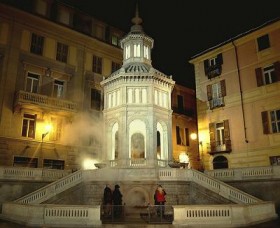 Acqui Terme is an ancient Roman spa town where the mineral rich waters are captured in the towns Terme. In addition to the public Terme, there are private spas and high end hotels that also harness this naturally rich water and it is integral to their various spa treatments, the most well known being the Grand Hotel Thermes.
Acqui Terme is an ancient Roman spa town where the mineral rich waters are captured in the towns Terme. In addition to the public Terme, there are private spas and high end hotels that also harness this naturally rich water and it is integral to their various spa treatments, the most well known being the Grand Hotel Thermes.
From Diana’s house, you can see the Alpi mountains of Liguria, so I guess it should be no surprise that this little city (population 23k) has more of a Ligurian than a Piemontese/Langhe feel. The buildings are all shades of pastels and with the palm trees and fountains one feels like they are at a seaside resort vs a medieval hill top city.
What is most impressive about Acqui Terme is the complete renovation of the historic center. Diana and Michael explained to me that awhile back the residents of the historic town center were given two choices: interest free loans to renovate their buildings or else up and sell to the Comune. 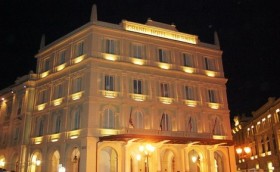
Well, it was a clever idea because given the wide streets, grand piazzas and pedestrian walkways, it is a pleasure just strolling around the city center as each corner brings a photo opportunity. Diana summed it up well by saying it is a very precious city.
The wines in the area tend to be more Barbara d’Asti, Dolcetto and the sweeter wines (ie. Moscato). Surely booking in a spa treatment would be a pleasurable way to spend part of the afternoon if you venture there (I certainly will try on my next visit) and if you find yourself in the city center around aperitvo time, Diana took me to a lovely wine bar, La Fonte del Vino, that has tables outside in the piazza in the summer time and the best buffet of nibbles I had seen in a long time to enjoy along with your glass of wine.
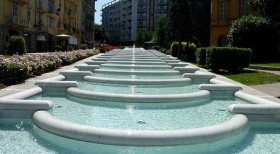 So, of all my “A” neighbours, Acqui Terme would be #1 on my list. Alessandria #2, and Asti comes in a poor #3 relative to the competition. As I mentioned earlier on, Aqui Terme is only 1 hour away from TorreBarolo, but if you want to spend more time in this little gem, I’d highly recommend you booking at Diana’s B&B.
So, of all my “A” neighbours, Acqui Terme would be #1 on my list. Alessandria #2, and Asti comes in a poor #3 relative to the competition. As I mentioned earlier on, Aqui Terme is only 1 hour away from TorreBarolo, but if you want to spend more time in this little gem, I’d highly recommend you booking at Diana’s B&B.

Tags: Acqui Terme, Barbera d'Asti, Baur B&B, Bollente, Dolcetto, Grand Hotel Thermes, La Fonte del Vino, Langhe, Liguria, Moscato, Piemonte, TorreBarolo
 Dolcetto wines are known for black cherry and licorice flavours with some prunes and a characteristically bitter finish reminiscent of almonds. While the name implies sweetness, the wines are normally dry. The tannic nature of the grape contributes to a characteristic bitter finish.
Dolcetto wines are known for black cherry and licorice flavours with some prunes and a characteristically bitter finish reminiscent of almonds. While the name implies sweetness, the wines are normally dry. The tannic nature of the grape contributes to a characteristic bitter finish.





 Acqui Terme is an ancient Roman spa town where the mineral rich waters are captured in the towns Terme. In addition to the public Terme, there are private spas and high end hotels that also harness this naturally rich water and it is integral to their various spa treatments, the most well known being the
Acqui Terme is an ancient Roman spa town where the mineral rich waters are captured in the towns Terme. In addition to the public Terme, there are private spas and high end hotels that also harness this naturally rich water and it is integral to their various spa treatments, the most well known being the 
 So, of all my “A” neighbours, Acqui Terme would be #1 on my list. Alessandria #2, and Asti comes in a poor #3 relative to the competition. As I mentioned earlier on, Aqui Terme is only 1 hour away from TorreBarolo, but if you want to spend more time in this little gem, I’d highly recommend you booking at Diana’s B&B.
So, of all my “A” neighbours, Acqui Terme would be #1 on my list. Alessandria #2, and Asti comes in a poor #3 relative to the competition. As I mentioned earlier on, Aqui Terme is only 1 hour away from TorreBarolo, but if you want to spend more time in this little gem, I’d highly recommend you booking at Diana’s B&B.









